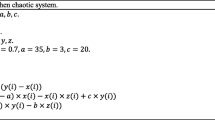Abstract
Low density parity check code (LDPC) is a linear block code whose performance is close to Shannon’s limit. Compared with other decoding algorithms, it has low decoding complexity and flexible structure. So it becomes people’s research hotspots. In recent years, LDPC code codec algorithm has been improved, and is widely used in deep space communications, optical fiber communications, mobile communications and underwater and other fields. Using chaotic sequence single-layer mapping plus pixel scrambling can complete chaotic image encryption, because some chaotic sequence is poor robust, in the process of channel transmission, it is difficult to ensure that the information can be destroyed after the attack In this paper, LDPC codes are introduced, and in the chaotic image encryption, block coding is used to form error protection to improve the stability of the image transmission process and improve the transmission quality.









Similar content being viewed by others
References
Chaudhary, R., Singh, P., Agarwal, A.: A security solution for the transmission of confidential data and efficient file authentication based on DES, AES, DSS and RSA. Int. J. Innov. Technol. Explor. Eng. 1(3), 5–11 (2012)
Mackay, D.J.C.: Good error-correcting codes based on very sparse matrices. IEEE Trans. Inform. Theory 45(2), 399–431 (1999)
Tang, T.: Application research of information hiding technology based on LDPC codes. Dissertation, Yantai University, Yantai (2015)
Moon, T.K.: Error Correction Coding: Mathematical Methods and Algorithms. Wiley-Interscience, New York (2005)
Wang, H.X.: Research and improvement of LDPC coding algorithm. Dissertation, Beijing Jiaotong University, Beijing (2009).
Ausloos, M., Dirickx, M.: The Logistic Map and the Route to Chaos, vol. 264, pp. 222–225. Springer, Berlin (2006)
Svensson, M., Malmquist, J.E.: A simple secure communications system utilizing chaotic functions to control the encryption and decryption of messages. http://citeseer.nju.nec.com, Accessed 29 Jan 1996
Xiao, H., Banihashemi, A.H.: Improved progressive-edge-growth (PEG) construction of irregular LDPC codes. Commun. Lett. IEEE 8(12), 715–717 (2004)
Chen, Z.H.: Application of irregular LDPC code in digital watermarking. Comput. Eng. Appl. (2010)
Shen, S.J., Shi-Feng, O.U., Wei, J., et al.: Study of digital image watermark application based on LDPC code technology. China Integr. Circ. (2016).
Sibel, J.C., Reynal, S., Declercq, D.: Evidence of chaos in the belief propagation for LDPC codes. Proceedings 1, 3–18 (2013)
Sipser, M., Spielman, D.A.: Expander codes. IEEE Transact. Inform. Theory 42(11), 1710–1722 (1996)
Dmitriev, A.A., Dmitriev, A.S., Andreyev, Y.V., et al.: Evaluation of the number of keys in a chaotic cryptographic method. Underst. Complex Syst. 3, 171–181 (2013)
Zhou, L.H., Feng, Z.J.: A new idea of using one-dimensional PWL map in digital secure communications-dual-resolution approach. IEEE Trans. Circ. Syst. II Analog Digit. Signal Process. 47(10), 1107–1111 (2005)
Xing, Y.W., Xiao, J.W.: Design of chaotic pseudo-random bit generator and its application in steram-cipher cryptogtaphy. Int. J. Modern Phys. C 19(05), 813–820 (2008)
Liu, Z., Xu, L., Liu, T., et al.: Color image encryption by using Arnold transform and color-blend operation in discrete cosine transform domains. Opt. Commun. 284(1), 123–128 (2011)
Liu, P.: Research on compilation algorithm of LDPC codes and its application in CMMB system. Dissertation, Jilin University, Changchun (2014)
Yang, X., Xu, Q., Zhuang, Y.: The application of chaos in sequence cipher system. J. Changzhou Inst. Technol. Z1, 43–45 (2013)
Sheng, L., Sun, K., Li, C.: Discrete chaotic system and its performance study of elliptical reflection cavity based on shear delay. J. Phys. 53(9), 2871–2876 (2004)
Sun, K., Liu, W., Zhang, T.: The implementation of a chaotic encryption algorithm. Comput. Appl. 23(1), 15–17 (2003)
Chen, Z., Liang, Z.: Application of irregular LDPC codes in digital watermarking. Comput. Eng. Appl. 46(8), 103–105 (2010)
Author information
Authors and Affiliations
Corresponding author
Rights and permissions
About this article
Cite this article
Wang, Zx., Lou, Y., Wang, Wq. et al. Research on the application of LDPC code in chaotic sequence image encryption. Cluster Comput 22 (Suppl 3), 6359–6370 (2019). https://doi.org/10.1007/s10586-018-2134-y
Received:
Revised:
Accepted:
Published:
Issue Date:
DOI: https://doi.org/10.1007/s10586-018-2134-y




